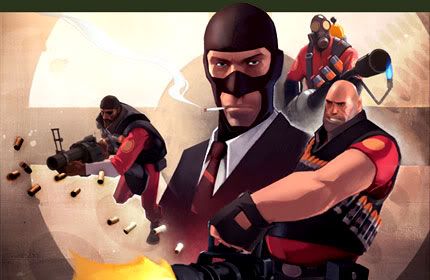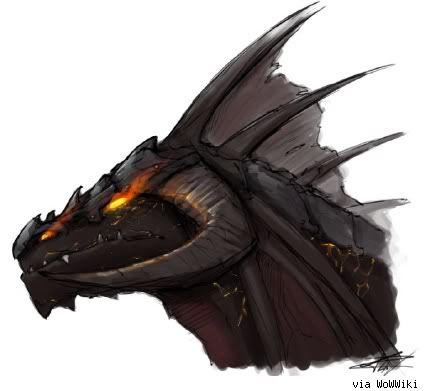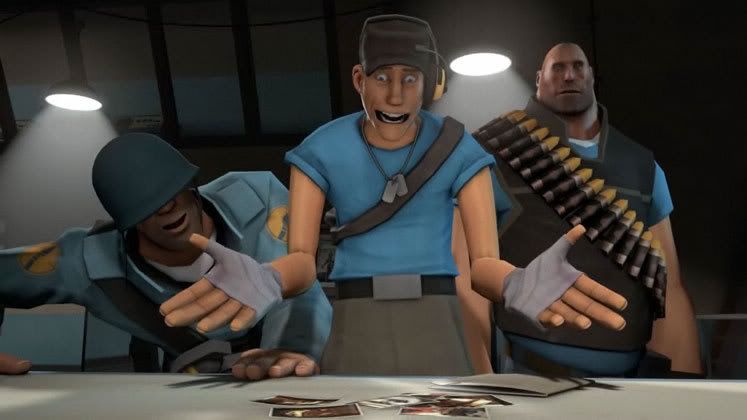
I've been accused, in the past, of being
something of a care bear when it comes to PvP content in games. Thankfully, there's help, even for someone like me. I'm slowly rediscovering what it means to take joy in the misery of other players, thanks to my
return to Team Fortress 2. Along with a resurgence of a competitive nature that more often than not takes the form of a stream of expletives, as 2Fort is SRS BZNS*, it's given me cause to think about what makes good and not-so-good PvP content in both tabletop and on-line games. In single-player games, it's good to have a single villain or a group of antagonists that clearly stand between the player and their objective. And straight-forward dungeon crawls often benefit from pitting multiple players against a single intelligence, be it a human GM or a programmed AI that respawns enemies as you click your way around the dark tunnels. As much as the Steam game
Torchlight evokes the nostalgia of hours spent exploring the many and varied underground demon-guarded caches of loot in
Diablo II, it misses the benefits of many people diving into the game to face more powerful enemies in the name of grabbing shinier equipment. But I'm wandering off my point, which is that in those cases, it's good to have a single bad guy. But what happens when your potential player base expands beyond a handful of intrepid adventurers? Sometimes, you just have to pit one group of adventurers against another. There are a few ways to do this.
1. Always Evil, All The Time

In the old World of Darkness, most notably in
Vampre: The Masquerade, factions were a completely player-based thing. While the threat of the Antideluvians coming back to life and consuming their children in an orgy of blood-fueled Armageddon was an ever-constant threat, most of the night-to-night problems were caused by one group of vampires (the Camarilla) fighting against the other (the Sabbat). What was the cause of this conflict, you ask? The Sabbat's evil. Now, no vampire can really be described as 100% "good," no matter what Team Edward might say. Even your most approachable and human-friendly blood-sucking fiend
is still a blood-sucking fiend. But if the Camarilla are vampires who talk nice to their cows before killing them in a humane way in order to carve them into delicious well-made marinated steaks, the Sabbat laugh as they kick the cows mooing into a giant meat grinder to churn out the greasiest, nastiest, cheapest "heart-attack-on-a-bun" burgers possible, selling them to the public at $10 US a pop as 'classic American hamburgers'. There may or may not be babies in there, too. Baby cows, hopefully. Though I wouldn't rule out kittens. This conflict is built into the core game. There's no ambiguity or much room for interpretation, one side's less evil and more amenable towards humanity, while the other is thoroughly nasty and definitely not family-friendly. While it can be fun to be the bad guy every now and again, having your entire motivation be puppy-punting grandma-incinerating nastiness all day every day gets a bit old after a while. Which might be why that game ended. Anyway, future iterations of the World of Darkness would see factions be more ambiguous in certain ways, and rather than saying "X and Y are locked into AN ETERNAL STRUGGLE FOR SUPREMACY UNTIL KINGDOM COME," it's much more "Here are some factions you guys can play in. Decide for yourselves how they get along. Have fun!"
2. Affably Evil, or Evilly Affable?
 Team Fortress 2
Team Fortress 2 is a bit like that. Neither
RED nor
BLU is clearly defined as being on one side or the other of the "Good/Evil" scale. Leaving aside the role the Announcer may or may not play in the conflict, the motivations of the teams pretty much boil down to healthy competition. With live ammunition and sharp objects. Not to mention explosives. Anyway, the point is that it's up to individual players to fill in the blanks. It's a straightforward, simple system that works well in on-line shooters. It could almost be considered the polar opposite of the strict pigeonholing of the old World of Darkness. When you get into on-line games involving more than a few dozen players, though, things get a bit more complex.
3. The Enemy of My Enemy Is My Enemy, Too
 World of Warcraft
World of Warcraft and
Aion have something in common. The players in these games select one of two factions, which are essentially flip sides of the same coin. They do fight each other, but larger external threats demand the attention of both sides and can sometimes lead to alliances of convenience (the Wrathgate in WoW for example). This allows players access to both PvP and PvE play styles, and interested parties can either strike a balance of time between both, or eschew one entirely in pursuit of excellence in the other. Or people can do what I used to do, which is fart around on dailies trying to earn enough money for a flying mount that's only slightly faster than one I could build with my bare hands as an Engineer. More on this when I discuss
World of Warcraft more in-depth on Saturday. There's change coming, and it might be good. Good enough to return to Azeroth? The jury's still out. Basically, when you want to engender player-versus-player conflict in your games, be it on the table or through the Intertubes, it's best to let it grow on its own. Give players fields in which to compete and let them go at it. There's really no need to give them motivations other than "they're not on our side." However, if you want to give the other side a nudge, just hit 'em with incriminating photos of a family member. Their mom, for instance.
 *No, not really.
*No, not really.
Blue Ink Alchemy










No comments:
Post a Comment